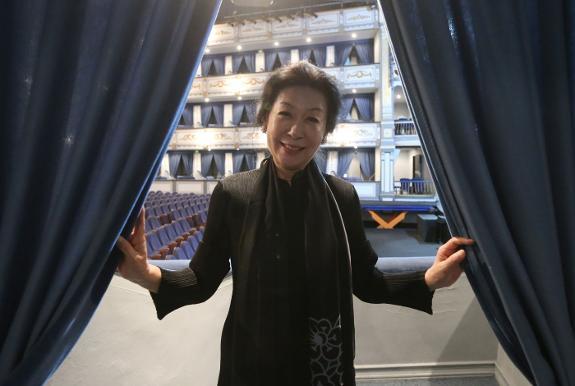Lorca, Korean-style
In 1971 she founded the first "Korean-style modern dance company" and still has the will to experiment: "I'd love to create a flamenco fusion"
REGINA SOTORRÍO
Martes, 23 de octubre 2018, 13:11
Kim Bock Hee always smiles as she speaks, even if the word coming out of her mouth is 'death'. She speaks with a calm delicacy and elegance, just like in her dance. A dance that reconciled her with her fears, which gave her the courage to break gender roles in her country and that has made her a pioneer of performing arts in South Korea. She was the first to found a company of "modern Korean dance" in 1971 and now, at 71, she is the first to make Lorca dance to an oriental rhythm.
The choreographer presented the show 'Danza de Perfume' on Wednesday at the Teatro Cervantes in Malaga. It consisted of three pieces, one of which was her own particular vision of Federico García Lorca's Blood Wedding.
The idea of death connects her with Lorca. She says that the loss of her parents made her obsess about it from a young age. In her search for references, she came across the poet from Granada, almost unknown in South Korea. She read his works, watched films about him and then decided to transform it into choreography in her own way, incorporating her traditions and the Buddhist beliefs with which she grew up.
In her version of Blood Wedding, life does not end with the final breath as in Buddhism "there is always rebirth". The wedding and the funeral in one of the poet's masterpieces here are a "Korean-style" wedding and burial with its corresponding rituals and clothing. "Lorca captures the essence of the human. There is a fight, conflict, love...," explains the choreographer. And "many plays express it", but it has never been done through the "subtlety and flexibility" of oriental contemporary dance.
A lot calmer
Death also appears in one way or another in 'The flower of existence and the flower of vanity' and 'Traces. Where my moon is', the other two pieces that the Korean presented on her debut in Malaga, part of the Ciclo de Danza, in collaboration with the Korean Cultural Center and Malaga university. However, through so much dancing with death, Kim Bock Hee has ended up losing the fear of it: "By getting rid of it you live a lot calmer."
Kim Bock Hee dared to experiment with the movement of the body in a "difficult time" in South Korea when the only contemporary dance that was seen on stage was the one brought by foreigners.
She trained in classical ballet and traditional dance since she was a child, but shortly after turning 20 in 1971, she founded the first Korean company that did neither one nor the other. "I thought that if there was modernity in the West, there was also modernity in Korea and I wanted to express it," she adds. To do that she had to break down the prejudices that kept men away. "There were women who played the male roles," she says. She "recruited" male gymnasts for her project and "they are now famous choreographers".
She was also a gymnast and still has a fit and agile body. In Malaga she didn't dance, but performed in Korea just ten days previously. "It keeps me young," she admits, but also keeps her desire to continue experimenting burning: "I would like to merge flamenco with my dance one day. It has a lot of richness in all its movements and in all sounds."
